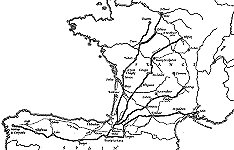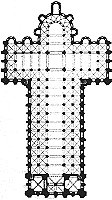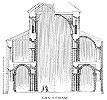Pilgrimage Churches |
Pilgrimage Churches |
 One of the most important artistic developments in the Romanesque period is the pilgrimage church. On the European continent, most of the routes led to Santiago de Compostela, the burial place of St. James the Greater. Along the way other churches were built -- to showcase their important relics and attract pilgrims, an economic advantage to developing medieval towns. Pilgrimages were an important feature of public devotion, done as an act of contrition or in hope for a miraculous cure from some physical ailment. By venerating saints, pilgrims hoped for remission of sins or release from disease.
One of the most important artistic developments in the Romanesque period is the pilgrimage church. On the European continent, most of the routes led to Santiago de Compostela, the burial place of St. James the Greater. Along the way other churches were built -- to showcase their important relics and attract pilgrims, an economic advantage to developing medieval towns. Pilgrimages were an important feature of public devotion, done as an act of contrition or in hope for a miraculous cure from some physical ailment. By venerating saints, pilgrims hoped for remission of sins or release from disease.

|
The plan was designed to accommodate large crowds so that pilgrims could circulate around the building, along aisles, and past the shrine that was usually displayed near the altar. Pilgramage churches are large and generally have a long transept which intersects the nave. They often have a tower over the crossing of the nave and transept. (Contrast this plan with the early Christian basilica--a simple rectangle without a transept.) Characteristic of pilgrimage churches are their ambulatories, the hallways and aisles which circulate around the periphery ("ambulatory" means a place to "amble" or walk), and their radiating chapels -- small rooms which radiate from the main plan. |
|
St. Sernin Church Toulouse, France end of 11th century
| |


|
St. Sernin is a typical, early example of the pilgrimage church. The apse (the end opposite from the entrance) has radiating chapels where pilgrims could pause to pray and admire important relics. Note the crossing tower as well.
The nave interior of St. Sernin is also typically Romanesque. The high stone ceiling is barrel vaulted, a technique developed by the Romans -- thus the name Romanesque. The walls are thick and heavy piers support the stone ceiling. The bay divisions are clearly marked by ribs which continue around the vaulted ceiling--called transverse vaulting. Instead of a continuous volume of space, as in the early Christian basilica, the nave is broken into identical, repeated volumes of space. The church is poorly lit since large window openings would violate the support structure of the walls. |
|
St. Etienne Church Caen, France 1064-77 |
|


|
A church founded by William the Conqueror, St. Etienne has a typical Romanesque elevation and nave wall. A second story gallery is above the side aisles and small windows illuminate the nave. Note the round arches of the nave wall and the clear divisions between bays. |
All images marked MAS were photographed on location by Mary Ann Sullivan. All other images were scanned from other sources or downloaded from the World Wide Web; they are posted on this password-protected site for educational purposes, at Bluffton College only, under the "fair use" clause of U.S. copyright law.